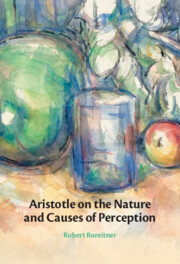Refine search
Actions for selected content:
145 results
1 - The Potential of Universal Biology
-
- Book:
- Universal Biology
- Published online:
- 11 November 2025
- Print publication:
- 20 November 2025, pp 1-30
-
- Chapter
- Export citation
120 - Adult Order Sets: General Order Sets
- from Subsection 12A - Order Sets – Adult
-
-
- Book:
- Observation Medicine
- Published online:
- 27 June 2025
- Print publication:
- 26 June 2025, pp 856-860
-
- Chapter
- Export citation
4 - Modes of Teaching
-
- Book:
- Teaching Modern Languages
- Published online:
- 04 September 2025
- Print publication:
- 12 June 2025, pp 59-75
-
- Chapter
- Export citation
Chapter 1 - Accounting for Receptivity
-
- Book:
- Aristotle on the Nature and Causes of Perception
- Published online:
- 01 May 2025
- Print publication:
- 22 May 2025, pp 24-43
-
- Chapter
-
- You have access
- Open access
- HTML
- Export citation
Chapter 6 - Perception as a Discriminative Activity
-
- Book:
- Aristotle on the Nature and Causes of Perception
- Published online:
- 01 May 2025
- Print publication:
- 22 May 2025, pp 165-197
-
- Chapter
-
- You have access
- Open access
- HTML
- Export citation
Chapter 7 - Reception of Forms without the Matter and Its Unmoved Causes
-
- Book:
- Aristotle on the Nature and Causes of Perception
- Published online:
- 01 May 2025
- Print publication:
- 22 May 2025, pp 198-226
-
- Chapter
-
- You have access
- Open access
- HTML
- Export citation
Chapter 2 - The Predecessors’ Dilemma
-
- Book:
- Aristotle on the Nature and Causes of Perception
- Published online:
- 01 May 2025
- Print publication:
- 22 May 2025, pp 44-71
-
- Chapter
-
- You have access
- Open access
- HTML
- Export citation
Chapter 3 - Complete Passive Activity
-
- Book:
- Aristotle on the Nature and Causes of Perception
- Published online:
- 01 May 2025
- Print publication:
- 22 May 2025, pp 72-99
-
- Chapter
-
- You have access
- Open access
- HTML
- Export citation
Conclusion
-
- Book:
- Aristotle on the Nature and Causes of Perception
- Published online:
- 01 May 2025
- Print publication:
- 22 May 2025, pp 227-229
-
- Chapter
-
- You have access
- Open access
- HTML
- Export citation
Introduction
-
- Book:
- Aristotle on the Nature and Causes of Perception
- Published online:
- 01 May 2025
- Print publication:
- 22 May 2025, pp 1-23
-
- Chapter
-
- You have access
- Open access
- HTML
- Export citation

Aristotle on the Nature and Causes of Perception
-
- Published online:
- 01 May 2025
- Print publication:
- 22 May 2025
-
- Book
-
- You have access
- Open access
- Export citation
The radical innovation design comparator to evaluate the effectiveness of design solutions according to usage contexts
-
- Journal:
- Design Science / Volume 10 / 2024
- Published online by Cambridge University Press:
- 10 December 2024, e44
-
- Article
-
- You have access
- Open access
- HTML
- Export citation
Regional neural functional efficiency across schizophrenia, bipolar disorder, and major depressive disorder: a transdiagnostic resting-state fMRI study
-
- Journal:
- Psychological Medicine / Volume 54 / Issue 15 / November 2024
- Published online by Cambridge University Press:
- 18 November 2024, pp. 4083-4094
-
- Article
-
- You have access
- Open access
- HTML
- Export citation
Activity/Composition Relations among Silicates and Aqueous Solutions: II. Chemical and Thermodynamic Consequences of Ideal Mixing of Atoms on Homological Sites in Montmorillonites, Illites, and Mixed-Layer Clays
-
- Journal:
- Clays and Clay Minerals / Volume 31 / Issue 3 / June 1983
- Published online by Cambridge University Press:
- 02 April 2024, pp. 207-217
-
- Article
- Export citation
Chapter 8 - The Physics and Metaphysics of Artefacts
-
- Book:
- Aristotle's Ontology of Artefacts
- Published online:
- 14 December 2023
- Print publication:
- 21 December 2023, pp 251-275
-
- Chapter
-
- You have access
- Open access
- HTML
- Export citation
Evolution of the magnetic field and flows of solar active regions with persistent magnetic bipoles before emergence
-
- Journal:
- Publications of the Astronomical Society of Australia / Volume 40 / 2023
- Published online by Cambridge University Press:
- 06 December 2023, e059
-
- Article
-
- You have access
- Open access
- HTML
- Export citation
Chromosphere activity: relations with Solar cycles (SC)
-
- Journal:
- Proceedings of the International Astronomical Union / Volume 19 / Issue S365 / December 2023
- Published online by Cambridge University Press:
- 23 December 2024, pp. 163-166
- Print publication:
- December 2023
-
- Article
- Export citation
Chapter 15 - Agency As the Direction and Reach of Actions
-
-
- Book:
- Agency and Transformation
- Published online:
- 23 November 2023
- Print publication:
- 30 November 2023, pp 355-382
-
- Chapter
- Export citation
5 - Habitat, Space Use and Feeding Ecology of the African Buffalo
- from Part II - Ecology
-
-
- Book:
- Ecology and Management of the African Buffalo
- Published online:
- 09 November 2023
- Print publication:
- 23 November 2023, pp 133-152
-
- Chapter
-
- You have access
- Open access
- HTML
- Export citation
1 - Action and the Will
- from Part I - Dimensions of Moral Conduct
-
- Book:
- Of Moral Conduct
- Published online:
- 08 June 2023
- Print publication:
- 22 June 2023, pp 11-20
-
- Chapter
- Export citation



